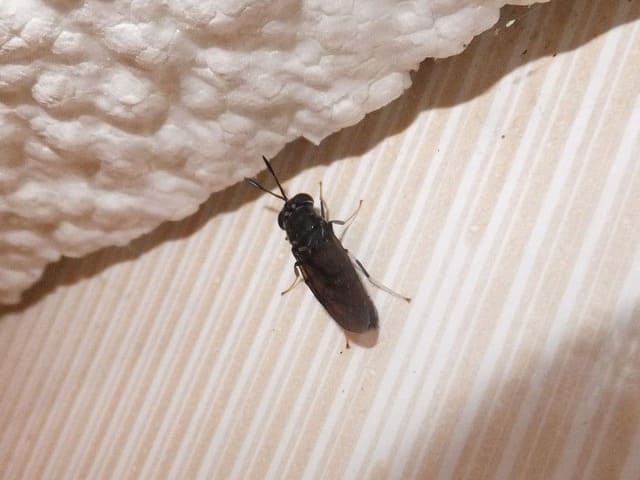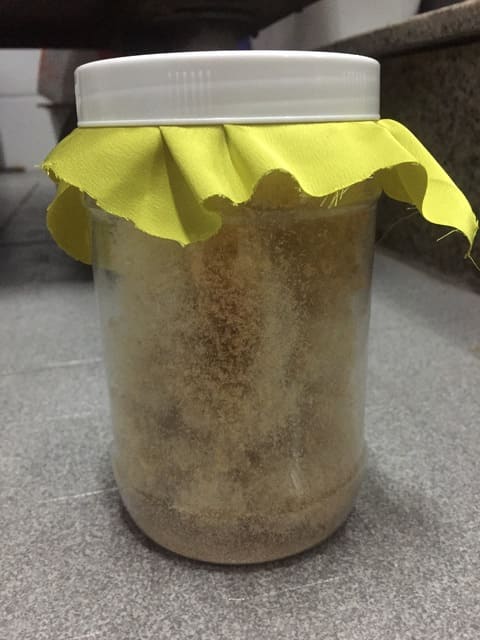Incubating BSF eggs is in general a simple & easy process. The thing to keep in mind is not to over-complicate things. There's only a few heads-ups to note. Let's check the process out now.
The first step we can begin with is:
Step 1: Prepare the Hatching Substrate
The hatching substrate or the starter feeding bed is usually the key for this incubation process. You can use rice bran, chicken broiler feed or cornmeal. Mix in some water to make the feed bed soft & moist. Around 60-70% humidity would be best for hatching.
The issue growers usually find with chicken feed substrate is that it tends to dry up really fast, especially in hotter climates. This creates a hardened bedding that makes it hard for the hatchlings to crawl around & get good oxygen supply. Also, when the substrate is too wet, the young hatchlings may drown. Runny substrate also tends to dry up quickly as well.
A good mix ratio is 1:1 or less. For 1 kg/lb of rice bran, for example, you could mix in about 1 kg/lb of water or just about 700 ml. Alternatively, you can dump chicken feed in a bucket & add water about a finger-length above the feed surface. Let it soak there for 4-5 days. We don't mix or swirl it around because it may turn the substrate watery or too thick. You can ferment it for a few days before using.
A good substrate is one that's a bit fluffy, cool when held in hand or cool to the touch & is moist. If the feed goes dry after several hours, spray the bedding with some water.
Step 2: Place the Eggs on the Substrate
A good placement can help reduce egg loss due to the contact with moisture or water. Initially, growers place a piece of paper or cardboard on the feed bed, then they put the eggs directly on it. Visually, it's something like this:
| Layering of eggs & substrate |
|---|
| eggs |
| cardboard |
| substrate |
Because the substrate is moist, water evaporates out, seeping through the cardboard paper & getting into direct contact with the eggs. As there may be some salt content in the rice bran or the protein content in the chicken feed contained in the substrate, this can make the eggs go bad. In certain cases when it's hot, the hot water vapor may just steam the eggs.
From this experience, people add an extra layer between the eggs & the bedding so they don't directly come into contact with (or touch) each other. A mesh screen is a good separating layer & won't rust easily. There are openings on the screen to let the water vapor out. And the eggs never touch the water directly, so chances of them rotting are reduced. Fiberglass or inox screen is good for this purpose.
With these two steps, you're basically set up for incubating your BSF eggs. All we need to do now is wait for the magic to happen.
If you'd like to see some more, one point to note during this process is:
The Hatching Environment
Sometimes, the collected eggs will have the dead bodies of BSF on them. Get rid of the fly bodies so they won't attract ants to your hatching bin.
/dead-mama-bsf-flies-on-egg-collectors.jpg)
Also, some growers spray anti-ant solution around the box to keep them away. If you're using this solution, make sure the stuff doesn't get into direct contact with the eggs. The chemicals may damage them & the little hatchlings.
When you're first starting your BSF colony, you may notice ants or houseflies visiting around for the first two weeks or so. Once your colony is established, these little animals will disappear around your BSF bin. The flies & larvae excretes a certain smell that keeps other insects away. It can be quite powerful.
To retain the humidity of your hatching box, place it in a cool dry place. The shade will help keep the temperature nice and good. The warm temperature helps the eggs hatch a bit quicker. A good temperature for hatching is about 85F (29C).
If houseflies ever come near, here is a tip to keep them away:
How to Keep Houseflies Away from Your BSF Egg Box
Housefly maggots appear most often at the beginning & ending stage of the BSF larvae. Or specifically the hatching cream larvae stage & the darkened pupae stage.
Because these are the two stages that the BSF don't consume much of the foods. If there's quite a lot of foods in the bin, this leaves room for the extra foods which then invite the houseflies.
To keep the houseflies away, you can try covering the box with a print screen fabric with tight openings. Alternatively, pre-treating the substrate with some microbes can help shoo the houseflies away. Three useful ones are:
- Saccharomyces: found in bread yeast or beer yeast
- Lactobacillus: found in milk & yogurt
- Bacillus
Fancy as they may sound, these little creatures exist everywhere around us. Harvesting them is easy, fun and most of the time free. If you'd like to see three homemade recipes for making your own microbe solution, check out this post below. This mix is sometimes called EM, which is short for effective microorganism:
>> Blog post: How to make EM1 effective microorganism (3 recipes)
Remember don't put too much substrate in the beginning because it may turn moldy before the larvae have a chance to eat it. About 500 grams of substrate is okay for 50 grams of eggs. After 2-3 days after they hatch, we can transfer them to a more yummy bigger food house.
If you're an efficient (or lazy) grower, how about we try:
The Lazy Way to Incubate BSF Eggs
If you don't want to scrape the eggs out from the egg collectors (wood pieces), then you can place the whole egg collecting stack above the feeding bed. The downside to this method is that the eggs may take a bit longer to hatch–just about 1 day longer from a farmer's experience.
Without scraping though, we create less disturbance to the eggs on the wood surfaces. Sometimes, too much force might bruise them without our knowing.
If you get an egg box from some place, you can place the egg box on the separating screen. Be sure to introduce them slowly to their new home to prevent temperature or humidity shock. The rest of the process is pretty much the same as we've seen.
After about 3-4 days, you'll see the eggs turn a bit darker in color. If they are quite fluffy and lighter, it's a good sign the eggs have hatched. Congratulations at this point! You may not see the little hatchlings at this point because they are so tiny. As they feed on the starter food, they'll get bigger in no time.
/new-hatchling-larvae-black-soldier-fly.jpg)
Have fun & good luck with your incubation. If you have any questions or ideas, please share them. Many thanks! See you again here next time.
Credits:
Responses to Readers' Questions
Hi everyone, I have been breeding BSF larvae for my project. Last week I found many of them are dead. Does anyone have experience with these larvae? Could you give me some advice, please?
--> Thanks for your question. Are your BSF moving or not moving? If they are not moving but have formed a hard dark shell/chrysalis (the pre-pupae stage), then it is their natural cycle and they are still alive. About 2 weeks from here, they will emerge into adult flies.
If your BSF larvae are in cream color but are not moving, then they may either be dead or have gone into dormancy. These larvae go into sleeping mode when the temperature drops below 60F (or 15C) in a low-light environment.
You don't have to worry too much in this case either. Although they may not be wiggling much or eating much, they are very much alive. These guys are tough and durable. They won't die without enough food but just get skinnier. In a dark, cool environment like this, people can keep them alive for 6-8 months.
The only temperature points that may kill these grubs are when it gets way too hot (over 110F/43C), when we boil them (100C / 212F) or when we freeze them below 20F (-6C). If the larvae are dying, then you could check:
- The density: if it is too high, it could lead to the heat issue.
- The air flow: make sure there's good air circulation for the larvae to breathe
- The food: some feedstocks like brewery grains may create quite a hot environment & contain some alcohol in it. Be mindful of some pesticide/chemical residue in some fruits/veggies.
I hope this helps!
Thank you for the guide, do you think it is possible to incubate eggs without feed and collect them daily?
--> Thanks for your kind words & question. I think it is possible to let the eggs hatch without the feed. If you maintain a temperature of around 29C (85F) in a good not-too-hot & moist enough place, the eggs will naturally hatch out. It will hatch with good enough temperature and humidity. The point of the feed though is to provide food for the hatched larvae. And also a gathering place so they stay in one place. Because newborn hatchlings are so tiny, you don't want them to crawl all over the place. And spend time catching each one back. Other times, growers may not be available at the times of hatching and want to give food 3-4 days in advance for them. If you can find a place to gather them after hatching, it'll be easy for daily collection. As you collect them daily, you can reduce the feed or use very little or no feed at all. And just to add a note for you, usually just a 10 grams of starter feed would be enough to keep these tiny hatchlings happy in place. Happy BSF raising & I hope this helps!
For your information on hatching and collecting newborn larvae from the start, you may find this post helpful. I'll drop a link here if you wanted a look 'How to keep BSFL population uniform': https://zenyrgarden.com/how-to-keep-black-soldier-fly-larvae-population-uniform/
What happen when eggs of bsf is transported in a bottle of mix with maize brand. Can it hatch and tf so how long can it be able to hatch? Yrs OYO MARK
--> Thanks for your question. Regarding the hatching of bsf eggs in maize, you may want to check out this article:

On average, it only takes about 4 days for bsf eggs to hatch (under the right temp & humidity conditions). From my personal experience, in my order of bsf eggs, the eggs hatched into tiny larvae upon arrival. They still stay and wiggle around in the bottle. As long as there is oxygen and feed, the tiny hatchlings will survive. Due to post office delays, traffic jam or other unforeseenable situations, eggs may take days and weeks to reach their destination. This is why, sellers usually put some extra feed in the box for the larvae just in case. Maize bran is a good choice amongst several others that I've seen the sellers use.
You may also find this useful:

I hope this helps, see you again next time.
Share or pin this post!



